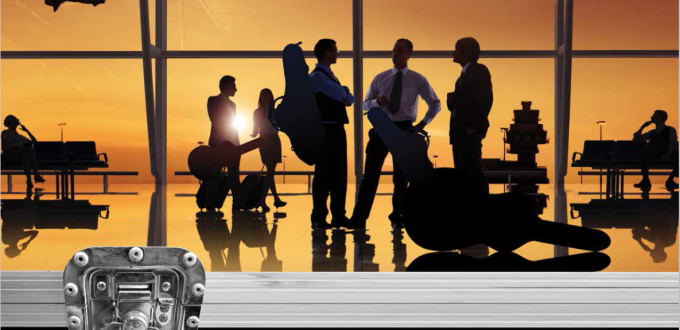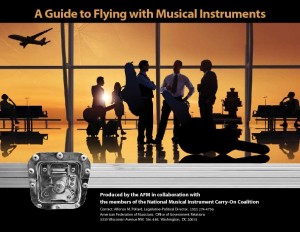Air Travel for Musicians
Traveling with your instrument can be challenging: given the importance and value of musical instruments to our livelihoods.
As of March 6, 2015, it’s official and no longer at the discretion of the various airlines. According to the U.S. Department of Transportation, musicians who board planes must be allowed to carry on their instruments provided they fit in the overhead bin. If this space isn’t large enough, the musician is also permitted to purchase a second seat in which to stow their musical companion. One caveat: the airlines don’t have to prioritize musical instruments ahead of any other carry-on luggage, so if the bins are full, you’ll still have to check your instrument at the gate. To remedy this, the DoT suggests that musicians may want to pay the airline’s fee for priority boarding to ensure that there will be room for their gear. Read the final ruling here.
In general, small musical instruments can be transported as your one carry-on baggage item if there is room in the overhead compartment or under the seat when you board and the instrument can be stowed safely.
Before flying, it is recommend that you contact your airline to discuss your instrument travel plans. One factor to remember is that smaller, regional aircraft can have limited overhead compartments. Also, it probably goes without saying, but be sure you invest in the right case for your instrument, whether you plan to carry it on or check it as cargo.
Allowing yourself plenty of time at the airport is also recommended. Having a specialty item can require a little more time to check baggage and navigate security. (See helpful information from the TSA regarding carrying instruments through screening checkpoints.)
To assist you in understanding airline policies, listed below are links to the pages on U.S. Based airlines’ websites that explain their policies.
Current Baggage Policies for Traveling with Musical Instruments
| Airline | Carry-On Baggage | Cabin Seat Baggage | Checked Baggage |
| Alaska Airlines Baggage Policy |
Standard carry-on policy applies. | Large musical instruments may be accepted as cabin seat baggage with purchase of full adult fare. | Standard checked bag policy applies. |
| American Airlines Instrument Policy |
A musical instrument may be taken onboard as your one carry-on bag, regardless of its size, as long as it can be safely stowed in an approved carry-on stowage location and space is available when you board. | Instruments that are too large to be stowed in an approved carry-on stowage location, or are too fragile to be checked may still be taken in the cabin and transported in a passenger seat if certain requirements are met, including purchase of a ticket for an additional seat. | Musical instruments can be checked as baggage. Liability for damage to checked instruments is limited under certain conditions explained on the AA website and in the contract of carriage. |
| Delta Air Lines Instrument Policy |
Guitars and other small musical instruments such as violins will be accepted as your free carry-on baggage item. These items must safely fit into the overhead bin or other approved storage location in the cabin, based on available space at the time of boarding. | If the instrument is too fragile to be checked, it may be checked as seat baggage. The item must meet certain requirements. | Musical instruments may be checked if certain requirements are met. |
| Hawaiian Airlines Baggage Policy |
Standard carry-on policy applies. | Passengers may purchase a seat for their fragile and/or bulky items. | Most musical instruments may be checked if certain requirements are met. |
| JetBlue Airways Instrument Policy |
A musical instrument is allowed in place of one carry-on item, provided it can be stowed properly under the seat or in an overhead bin at the time of boarding. | Musical instruments of a size that prevents the instrument from being handled as normal carry-on baggage will be accepted in the cabin and are subject to certain requirements. | A musical instrument will count as one piece of checked baggage and are subject to all applicable baggage fees. |
| Southwest Airlines Instrument Policy |
Musical instruments do not have to meet sizing requirements for carry-on items and will be accepted if they can be stowed safely under the seat or in an overhead bin at the time of boarding. | In the event you are traveling with a musical instrument that cannot be stowed safely as carry-on luggage, or is fragile in nature, you may purchase a seat for the instrument and carry it in the cabin under certain conditions. | Some musical instruments cannot be secured in a seat and must be transported as checked baggage, subject to applicable baggage fees. |
| United Airlines Instrument Policy |
A musical instrument may be carried on board as a carry-on item if it can be stowed safely overhead or in the seat in front of you at the time of boarding. | A customer may purchase a ticket for a musical instrument which is too fragile or bulky to be handled as checked baggage. Upright basses and guitars will not be accepted as cabin-seat baggage. | Checked instruments must meet certain requirements, including being packed in a hard-shell case. |
| US Airways Instrument Policy |
A musical instrument may be taken onboard as your one carry-on bag, regardless of its size, as long as it can be safely stowed in an approved carry-on stowage location at the time of boarding. | Instruments that are too large to be stowed in an approved carry-on stowage location, or are too fragile to be checked may still be taken in the cabin and transported in a passenger seat if certain requirements are met, including purchase of a ticket for an additional seat. | Musical instruments, considered fragile items, will be accepted as checked baggage if they are appropriately packaged in a container/case designed for shipping such items. Fragile items without appropriate packaging will be accepted upon the execution of a release furnished by US Airways. |
Have questions that aren’t answered in this post? Check out the DOT’s FAQs! You may also download a copy of the guidebook for musicians put together by the AFM and the National Musical Instrument Carry-On Coalition.



I would like to share your article in our newsletter for Iamradioworld.com
May I have your permission to include it making sure you are given credit?